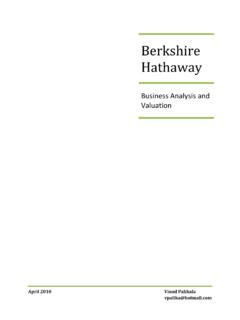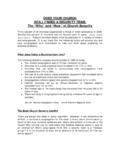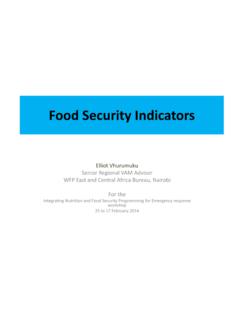Transcription of Security Analysis - vinodp.com
1 Notes to Ben Graham s Security Analysis 2nd and 3rd Editions Vinod Palikala August, 2009 As Graham notes in the preface, the book is concerned chiefly with concepts, methods, standards, principles, and, above all, with logical reasoning . To get the most out of this book, it is essential to see past the many seemingly rigid guidelines to understand Graham s reasoning. This is my attempt to summarize the main message Ben Graham is trying to convey. In the book, it is difficult to relate the specific topic being discussed with the broader context. I added comments and formatted the notes to make it easier to understand the overall message.
2 In many cases, I ended up just noting the most important points of each chapter. Part I is from the 3rd edition as this part is covered much more comprehensively in the 3rd edition. All the other parts are from 2nd edition which I found to be better organized and also easier to comprehend. Please send any feedback to Notes to Security Analysis by Vinod Palikala 2 Contents Part I: Survey and Approach .. 4 Chapter 1: Introduction .. 4 Chapter 2: The Scope and Limitations of Security Analysis .. 4 Chapter 3: The Behavior of the Security Markets .. 6 Chapter 4: Investment and Speculation .. 7 Chapter 5: Investment Policy.
3 9 Chapter 6: Nature and Sources of the Analyst s Information .. 10 Chapter 7: Quantitative and Qualitative Factors in Security Analysis . The Margin of Safety Chapter 8: Classification of Securities .. 13 Part II: Fixed Value Investments .. 14 Chapter 6: The Selection of Fixed Value Investments .. 14 Chapter 7: The Selection of Fixed Value Investments: Second and Third 15 Chapter 8: Specific Standards for Bond Investment .. 16 Chapter 9: Specific Standards for Bond Investment .. 17 Chapter 10: Specific Standards for Bond Investment .. 17 Chapter 11: Specific Standards for Bond Investment .. 18 Chapter 12: Special Factors in the Analysis of Railroad and Public Utility Bonds.
4 18 Chapter 13: Other Special Factors in Bond Analysis .. 19 Chapter 14: The Theory of Preferred Stocks .. 19 Chapter 15: Technique of Selecting Preferred Stocks for Investment .. 20 Chapter 16: Income Bonds and Guaranteed Securities .. 20 Chapter 17: Guaranteed Securities .. 20 Chapter 18: Protective Covenants and Remedies of Senior Security Holders .. 21 Chapter 19: Protective Covenants .. 21 Chapter 20: Preferred Stock Protective Provisions. Maintenance of Junior Capital .. 21 Chapter 21: Supervision of Investment Holdings .. 21 Part III: Senior Securities with Speculative Features .. 22 Chapter 22: Privileged Issues.
5 22 Chapter 23: Technical Characteristics of Privileged Senior Securities .. 24 Chapter 24: Technical Aspects of Convertible Issues .. 24 Chapter 25: Senior Securities with Warrants, Participating Issues, Switching and Hedging .. 24 Notes to Security Analysis by Vinod Palikala 3 Chapter 26: Senior Securities of Questionable Safety .. 25 Part IV: Theory of Common Stock Investment. The Dividend Factor .. 26 Chapter 27: The Theory of Common Stock Investment .. 26 Chapter 28: Newer Canons of Common Stock Investment .. 28 Chapter 29: The Dividend Factor in Common Stock Analysis .. 30 Chapter 30: Stock Dividends .. 33 Part V: Analysis of the Income Account.
6 The Earnings Factor in Common Stock Valuation .. 34 Chapter 31: Analysis of the Income Account .. 34 Chapter 32: Extraordinary Losses and Other Special Items in the Income Account .. 36 Chapter 33: Misleading Artifices in the Income Account. Earnings of Subsidiaries .. 37 Chapter 34: The Relation of Depreciation and Similar Charges to Earning Power .. 38 Chapter 35: Public Utility Depreciation Policies .. 40 Chapter 36: Amortization Charges from the Investor s Standpoint .. 41 Chapter 37: Significance of the Earnings Record .. 41 Chapter 38: Specific Reasons for Questioning or Rejecting the Past Record .. 44 Chapter 39: Price-Earnings Ratios for Common Stocks.
7 Adjustments for Changes in Capitalization .. 45 Chapter 40: Capitalization Structure .. 48 Chapter 41: Low Priced Common Stocks. Analysis of the Source of Income .. 50 Part VI: Balance Sheet Analysis . Implications of Asset Values .. 52 Chapter 42: Balance Sheet Analysis . Significance of Book Value .. 53 Chapter 43: Significance of Current Asset Value .. 53 Chapter 44: Implications of Liquidating Value. Stockholder Management Relationships .. 55 Chapter 45: Balance Sheet Analysis .. 56 Part VII: Additional Aspects of Security Analysis . Discrepancies between Price and Value .. 60 Chapter 46: Stock Option Warrants.
8 60 Chapter 47: Cost of Financing and Management .. 60 Chapter 48: Some Aspects of Corporate Pyramiding .. 60 Chapter 49: Comparative Analysis of Companies in the Same Field .. 61 Chapter 50: Discrepancies between Price and Value .. 64 Chapter 51: Discrepancies between Price and Value (Continued) .. 67 Chapter 52: Market Analysis and Security Analysis .. 68 Quotes .. 72 Notes to Security Analysis by Vinod Palikala 4 Part I: Survey and Approach Chapter 1: Introduction Objectives of Security Analysis 1. To present important facts regarding a stock or bond in a manner most informing and useful to an actual or potential owner.
9 2. Seeks to reach dependable conclusions, based upon facts and applicable standards as to safety and attractiveness of a given Security at the current or assumed price. Common Stock Classification Primary common stocks are those of large and prominent companies, generally with a good record of earnings and of continued dividends. There may be some 200 issues of this type about which there would be little dispute and perhaps similar amount that may be disputable. Secondary common stocks are marginal in the sense that they are regarded as very close to the primary grade and expected to reach that privileged status in due course.
10 Perhaps 80% of listed issues and 90% of unlisted issues belong to the secondary category. Market price behavior is influenced in significant ways by the category to which the stock belongs and should be taken into account. Graham rejects the standard notion of industry lifecycle expansion, slowing down, decline and complete decay or extinction. He believes the most striking characteristic of large American businesses is their repeated pendulum swings from better to poorer results and back. A remarkably small percentage of these enterprises actually go out of business through voluntary liquidation or sheriff s auction.









